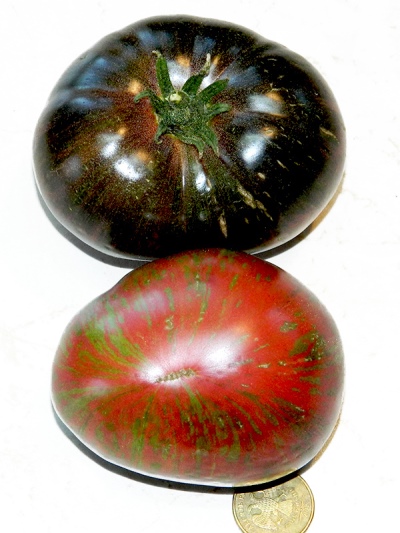
- Authors: USA
- Name synonyms: The Thong, Dwarf The Thong, Dwarf Strap, Dwarf Thong
- Category: grade
- Growth type: determinant
- Appointment: universal
- Ripening period: mid-season
- Ripening time, days: 110-120
- Growing conditions: for open ground
- Bush size: medium-sized
- Bush height, cm: 80-120
Increasingly, gardeners begin to grow new varieties of tomatoes in their beds and greenhouses in order to find the best one. The most popular among experienced gardeners is the Thong tomato.
Breeding history
This variety was developed by agronomists in the Australian continent and America in the 2000s. The stringy variety has entered the series of tomatoes under the name Gnome. It also includes a dozen varietal tomatoes. They are also called dwarven tomatoes.
Description of the variety
This vegetable has certain characteristics.
Bushes are medium-sized, semi-determinate type, about 1.5 m tall.
Their compactness makes it possible to grow this variety of tomatoes in thickened plantings.
Plants have wide and wrinkled leaves, emerald color.
The stem of the Thong tomato is quite powerful and sturdy.
Possesses persistent immunity to viral, fungal and bacterial diseases.
High yield of the variety.
Grown both in covered structures and without shelter.
The main qualities of the fruit
The Thong tomato has a large, flat-round fruit shape. At the ripening stage, the color of the tomato is dark olive, almost purple. Ripe Thong tomatoes are pinkish-purple in color with green stripes. Each fruit weighs between 150 and 250 grams.
Taste characteristics
If you cut the fruit, then the cut shows a dark cherry flesh. The taste of tomatoes is sugary, bulk and thick meat. You can feel the taste of spices and aromatic smell. This variety is notable for its good transportability, the degree of storage is assessed according to its high class.
Ripening and fruiting
This variety is ranked as a mid-season class. The growing season of the plant lasts 3 months. Then comes the ripening period, which lasts from 90 to 100 days. The red color of the tomato is provided by a chemical called lycopene. It is produced when the nights get cooler, but not below 8-9 degrees Celsius.
Yield
The variety is fruitful. About 3 kg of tomato can be harvested from a bush. Due to the high yield, it is necessary to tie the plants to the trellis, and partial pinching should be carried out. Excellent yield is observed when a bush is formed of 2-3 stems.
The timing of planting seedlings and planting in the ground
Since the stringy tomato belongs to the mid-season varieties, its growing period is 70-90 days. Therefore, it is sown for seedlings between March 1 and 15. If the seeds are sown earlier than the specified time, the plants will stretch out and outgrow. When landing in the ground, they will not take root well. With late sowing, not meeting the deadlines, the plants will lag behind in development. This will be reflected in a decrease in yield.
The vegetable is sown for seedlings, first at home on a windowsill or in a greenhouse, and when the threat of frost has passed, the plants are planted in open ground. For the Central Russian region, the planting period falls on the end of May and the beginning of June. Planting of plants in open soil occurs 2 months after the appearance of the first shoots.
In case of late frosts on the ground, you need to cover the tomato seedlings with lutrasil or spunbond.

Growing tomato seedlings is an extremely important process, because it largely depends on whether the gardener will be able to harvest at all. All aspects must be taken into account, from seedbed preparation to planting in the ground.
Landing scheme
Due to the compactness of the tomato bushes of this variety, they need a little space for growth and fruiting. For 6-8 tomato plants, 1 square meter is enough, as the bushes branch slightly. Pits for planting are dug at a distance of 30-40 cm from each other. The row spacing is about 50 cm.

Growing and care
Dwarf tomatoes are easy to care for. There are no difficulties with growing. The following measures are recommended for their cultivation.
Watering. Produced on average 2 times a week. Water as the topsoil dries up. Use settled water. And during the period of fruit setting, tomatoes require more moisture.
Loosening. It is carried out after the soil has dried to provide the roots of tomatoes with oxygen. If the plants do not have enough oxygen, they will feel depressed. They can wither and die.
Garter. It is necessary for a high yield of this variety of tomatoes. Supports are placed on the north side of the plant. The ideal distance from the bush to the support is 10-15 cm.
Top dressing. Traditionally held 3 times a season. In the first feeding, phosphate-potassium fertilizers are given for the growth of tomato seedlings. During the flowering period (second feeding) boron, magnesium and nitrogen are added. The third top dressing consists of potash fertilizers.




A plant needs different micronutrients at each stage of growth. All fertilizers can be divided into two groups: mineral and organic. Folk remedies are often used: iodine, yeast, bird droppings, eggshells.
It is important to observe the rate and period of feeding. This also applies to folk remedies and organic fertilizers.
Disease and pest resistance
The Thong tomato variety has good immunity and is resistant to various diseases such as late blight and macrosporiosis, which are characteristic of the nightshade family. To increase the resistance of plants, it is necessary to carry out preventive treatments with a solution of potassium permanganate or copper sulfate. It can also be treated with "Fitosporin" or "Shine".
The pests of this tomato variety include:
spider mite;
wire worm;
bear;
Colorado beetle.
To combat them, use such effective drugs as "Fufanon", "Aktara", "Iskra", "Fitoverm" and others.



























































































